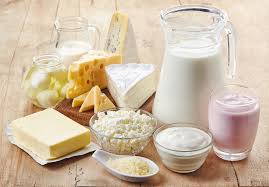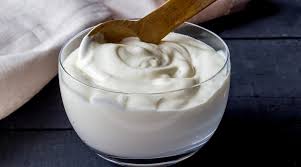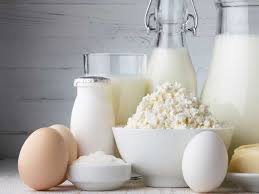This article focuses on eggs and dairy products, exploring their production, nutritional value, storage requirements, and culinary applications.
Eggs
The term “egg” applies not only to those of hens but also to the edible eggs of other birds, such as turkeys, geese, ducks, guinea fowl, quails, and gulls.
1. Nutritional Value
Eggs contain most essential nutrients and are low in calories: two eggs provide approximately 180 calories. Egg protein is complete and easily digestible, making it valuable for balancing meals. Eggs serve as a protective food, supplying energy and materials for growth and repair of the body. They can also be used as the main dish.
2. Grades of Eggs
Hens’ eggs are graded into four sizes:
i. Small: 48 g
ii. Medium: 58 g
iii. Large: 68 g
iv. Very Large: 76 g
The size of an egg does not affect its quality but influences its price. Eggs are tested for quality, then weighed and graded as follows:
Grade A: Naturally clean, fresh eggs, internally perfect with intact shells and an air cell not exceeding 6 mm (1/4 in) in depth.
Grade B: Eggs downgraded due to cleaning, preservation, internal imperfections, cracked shells, or an air cell exceeding 9 mm (3/8 in) in depth.
Grade C: Eggs suitable for breaking for manufacturing purposes but not sold in their shells to the public.
Read Also : Vegetative Structure of Seed Plants: The Leaf
Composition of Eggs (Approximate Percentages)

| Component | Whole Egg | White | Yolk |
|---|---|---|---|
| Water | 73% | 87% | 47% |
| Protein | 12% | 10% | 15% |
| Fat | 11% | 0% | 33% |
| Mineral | 1% | 0.5% | 2% |
Uses of Fresh Eggs
Eggs are used extensively in:
- Hors d’oeuvres
- Soups
- Egg dishes
- Fish dishes
- Sauces
- Meat and poultry
- Pasta
- Salads
- Sweets and pastries
- Savories
Uses of Egg Products
- Pasteurized whole egg: Hard-boiled eggs
- Salted whole egg: Pickled eggs
- Pasteurized yolk: Chopped hard-boiled with mayonnaise
- Salted yolk: Scrambled eggs
- Sugared yolk: Omelettes
- Pasteurized albumen: Egg custard blend
- Sugared albumen: Quiche blend
- Egg granules: Egg/milk blend
Other Types of Eggs
- Turkey and guinea fowl eggs may be used in place of hens’ eggs.
- Goose or duck eggs may be used only if thoroughly cooked.
- Quail eggs are used in some establishments as a garnish or hors d’oeuvres.
Dairy Products

1. Milk
Milk is a white, nutritious liquid produced by female mammals for feeding their young. The milk most commonly used is from cows, though goats’ milk and ewes’ milk are also utilized.
i. Nutritional Value
Milk makes a valuable contribution to daily eating patterns, helping meet nutritional needs as part of balanced, varied diets. It is a nutritionally complete food, containing a wide range of essential nutrients, particularly protein, calcium, B-group vitamins, and, in whole milk, vitamin A.
ii. Storage
Milk is a perishable product and must be stored carefully:
- Fresh milk should be kept in its delivery container and stored in the refrigerator (keeps for 4–5 days).
- Milk must be covered, as it easily absorbs odors from foods like onions and fish.
- Fresh milk should be ordered daily.
- Tinned milk should be stored in a cool, dry, ventilated place.
- Dried milk, packaged in airtight tins, should be kept in a dry store.
- Sterilized milk keeps for 2–3 months if unopened but, once opened, must be treated like pasteurized milk.
- UHT (Ultra-Heat-Treated) milk remains unrefrigerated for several months. Check the date stamp (expires 6 months after processing) and rotate stocks. Once opened, refrigerate and use within 4–5 days.
iii. Uses of Milk
Milk is used in:
- Soups and sauces
- Cooking fish and vegetables
- Making puddings, cakes, and sweet dishes
- Hot and cold drinks
2. Cream
Cream is the lighter portion of milk, containing all milk’s main constituents but in different proportions. It has a higher fat content and lower water content than milk. Cream is separated from milk and heat-treated.
Types of Cream and Their Fat Content
| Description | Minimum Butterfat Content (% by Weight) |
|---|---|
| Clotted cream | 55 |
| Double cream | 48 |
| Whipping cream | 35 |
| Whipped cream | 35 |
| Sterilized cream | 23 |
| Single cream | 18 |
| Sterilized half cream | 12 |
| Half cream | 12 |
Other Creams Available
- Extra thick double cream (48%): Homogenized and pasteurized, will not whip.
- Spooning cream or extra thick textured cream (30%).
- Frozen cream (single, whipping, or double).
- Aerosol cream: Heat-treated by UHT method to produce whipped cream.
- Soured cream (18%): Cream soured by adding a starter culture.
- Crème fraîche: A similar product with a higher fat content.
Read Also : Different Classes of Snail Feed Based on their Nutritional Requirements
3. Yoghurt

Yoghurt is a cultured milk product made from cows’, ewes’, goats’, or buffaloes’ milk. The taste and texture vary depending on the milk type and microbial activity. A bacterial starter culture is added, causing lactose to ferment and produce lactic acid.
Types of Yoghurt
- Stirred yoghurt: Smooth, fluid consistency.
- Set yoghurt: More solid with a firmer texture. All yoghurt is “live” and contains active bacteria that remain dormant at low temperatures unless pasteurized, sterilized, or ultra-heat-treated. At room temperature or above, bacteria become active, producing more acid, which can impair flavor and cause separation. Yoghurt is available plain (natural) or flavored, often with added fruit pieces.
Nutritional Value
Yoghurt is rich in protein, vitamins, minerals, and particularly calcium.
4. Cheese
Cheese is made from milk protein coagulated by an enzyme, such as rennet (an animal product). Vegetarian cheese uses a non-animal enzyme. It is produced worldwide from cows’, ewes’, or goats’ milk, requiring approximately 5 liters (9 pints) of milk to produce 0.5 kg (1 lb) of cheese. Hundreds of varieties exist, with many countries producing their own specialty cheeses.
i. Quality
- The rind should not show mildew, indicating damp storage.
- Cheese should not emit an overly strong smell or ammonia when cut.
- Hard, semi-hard, and blue-vein cheeses should not be dry when cut.
- Soft cheese should have a delicate, creamy consistency, not runny.
ii. Storage
- Store cheese in a cool, dry, well-ventilated area.
- Turn whole cheeses occasionally if stored for extended periods.
- Keep cheese away from foods that may be spoiled by its smell.
iii. Nutritional Value
Cheese is a highly concentrated food containing fat, protein, mineral salts, and vitamins, making it an excellent body-building, energy-producing, and protective food.
iv. Preservation
Certain cheeses are preserved by processing. A hard cheese is ground to a fine powder, melted, mixed with pasteurized milk, poured into molds, and wrapped in lacquered tinfoil (e.g., processed Gruyère, Kraft, Primula).
v. Uses
Cheese is used in soups, pasta, egg, fish, vegetable dishes, and savories.
Examples of Cheese
- Cheddar: Golden color, close texture, fresh mellow nutty flavor.
- Cheshire: Orange-red or white, loose crumbly texture, mild mellow slightly salty flavor.
- Double Gloucester: Orange-red, buttery open texture, delicate creamy flavor.
- Dunlop: A Scottish equivalent of Cheddar, milder and lighter in color and texture.
Care should be taken in selecting eggs and dairy products to avoid food poisoning. This article has outlined the types, nutritional value, uses, and preservation methods of eggs and dairy products, emphasizing their importance in culinary and nutritional contexts.
Do you have any questions, suggestions, or contributions? If so, please feel free to use the comment box below to share your thoughts. We also encourage you to kindly share this information with others who might benefit from it. Since we can’t reach everyone at once, we truly appreciate your help in spreading the word. Thank you so much for your support and for sharing!

